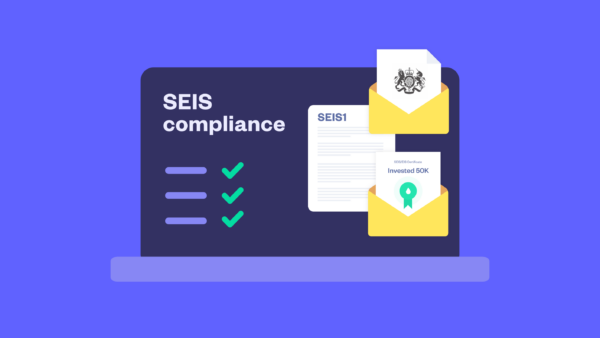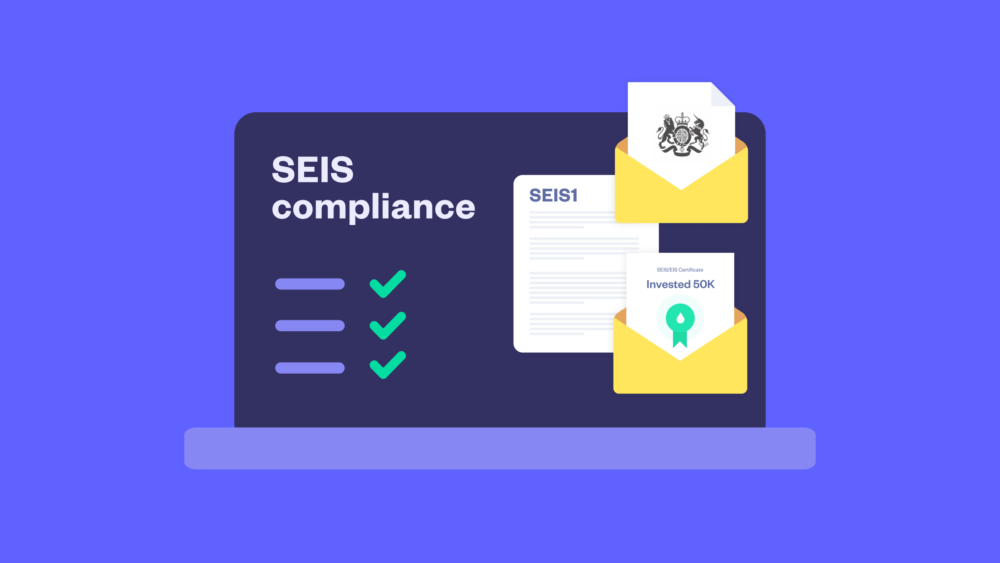SEIS: Guide to the Seed Enterprise Investment Scheme
Founders guide to SEIS. Find out how it helps startups and investors, eligibility criteria, how to get Advance Assurance...


Raised with SEIS or EIS? Congratulations! The slog of raising the money is over but there’s still some work to do for your investors to get the tax benefit from their investment: SEIS/EIS Compliance.
It’s unlikely you’ll forget this important step in your SEIS fundraising – your new investors will remind you because they need documents from your company to prove their investment was eligible for SEIS/EIS tax relief.
But don’t wait for investors to nudge you – stay ahead of the game by submitting your SEIS Compliance promptly. In this post, we explain SEIS Compliance: how to complete the SEIS Compliance statement and send investors the SEIS3 certificates they need to claim tax relief (we’ll just refer to SEIS in the rest of the article, but in general the same points apply for SEIS and EIS.)
The Seed Enterprise Investment Scheme (SEIS) is a UK government scheme designed to encourage entrepreneurship and investment in seed-stage businesses.
If an investment in your company is likely to qualify for SEIS – which you can prove with SEIS Advance Assurance – you’re more attractive to investors. This is because in exchange for investing in your company, the government offers them enticing tax breaks.
Need more detail? Head over to our guide to SEIS
After you’ve received your SEIS funding and issued shares to your investors, you’ll need to fill in a compliance statement (SEIS1) and send it to HMRC.
But you can’t send your compliance statement immediately after you’ve issued the shares. HMRC will only accept your compliance statement when you’ve carried out your qualifying business activity for at least four months, and spent at least 70% of the amount you raised.
Zlatina TrifonovaYou must submit your SEIS Compliance within 2 years of the date you carried out your qualifying business activity for 4 months, or within 2 years of the end of the tax year in which the shares were issued (whichever is later). If you leave it until after that, HMRC will deny SEIS or EIS because you left it too late.
But don’t wait until then because your investors will want their tax relief now, they’re going to start hassling you if you wait more than a few months from the time of their investment.
SEIS/EIS expert,
You must wait to send HMRC your compliance statement until you’ve carried out your qualifying business activity for at least four months, and spent at least 70% of the amount you raised.
You can fill in the form online at this gov.uk page, but it’s much easier to use SeedLegals to generate it for you
As part of your application, you’ll need to submit supporting documents such as the Memorandum and Articles of Association.
Already got SEIS Advance Assurance? Great – you won’t need to re-submit evidence that you’re eligible for the scheme (pitch deck, financial projections etc) unless something has significantly changed since you applied for Advance Assurance.
If you haven’t got Advance Assurance: That’s okay, Advance Assurance isn’t obligatory. But as part of the compliance process, you’ll need to submit proof that you meet the requirements for SEIS. The main supporting documents you’ll need to submit are:
Be dramatically more investable. Two-thirds of UK startups use SeedLegals to obtain Advance Assurance.
100% success.

The SEIS compliance is done electronically on the HMRC portal, but it’s much easier to do it on SeedLegals, and we take care of everything for you.
You need to do one SEIS/EIS Compliance for each unique date on which SEIS/EIS shares were issued.
HMRC will review your documents and you can expect an answer within two to four weeks.
To confirm the investment in your company qualifies for SEIS, HMRC will send you:
SEIS3 certificates show the Unique Investment Number HMRC assigned to the shares for this SEIS investment. Each investor needs an SEIS3 certificate to claim their tax relief from the government.
When you do your SEIS Compliance on SeedLegals, we automate the process of filling in these certificates, so you can generate them in a few clicks.
Then send each of your new investors their individual SEIS3 certificate. If you’ve done your SEIS compliance with SeedLegals, you can easily send each investor their certificate via SeedLegals.
HMRC can withhold or withdraw tax relief for your investors if you don’t follow the SEIS rules for at least three years after their investment.
The rules state you must spend the money you raised from the SEIS investment within three years of the date you issued the shares. And you must spend the money on:
The SEIS rules in full are at the gov.uk website.
Your investors will claim their tax relief when they fill in their annual self assessment tax return. On the Additional Information page, under ‘Other tax reliefs’, investors enter the total they’ve invested in companies under SEIS and EIS.
Investors can claim SEIS tax relief up to five years from 31 January of the year after the tax year in which they made the investment. (It’s 31 January because that’s the deadline for online self assessment tax returns.)
What if your investor is employed, paid by PAYE and doesn’t have to file a tax return? They need to fill in pages 3 and 4 of the SEIS3 certificate and post them to the HMRC address stated on their payslip and P60.
There’s a ‘carry-back’ option when filing for SEIS tax relief – this allows investors to claim tax relief for their Income Tax in the previous year, as well as in the same year they made the investment. For SEIS, investors can carry back up to £200,000 per tax year (before April 2023, this limit was £100,000).
Sorting out SEIS1 and SEIS3 forms used to be complicated and time-consuming. We’ve automated the manual form-filling so when you do your SEIS funding round on SeedLegals, the SEIS compliance is incredibly simple. We auto-generate and pre-fill the forms for you to sign and send.
Here’s how to complete your SEIS compliance on SeedLegals:
Download the compliance statement pack from SeedLegals and send by email:
or by post:
Venture Capital Reliefs Team
WMBC
HM Revenue and Customs
BX9 1BN
When you receive the SEIS2 letter from HMRC confirming the investment is approved for SEIS:
Find out more about how to complete your SEIS compliance on SeedLegals.
If you’re successful in growing your company after your SEIS funding round, you might move on to fundraise through EIS, the Enterprise Investment Scheme.
SEIS and EIS have similar rules and benefits for companies and investors, but EIS is for slightly larger companies and reflects the reduced risk for investors.
To see how the criteria for EIS compare to SEIS, take a look at our guide, SEIS vs EIS.
Got questions about SEIS? Our funding experts know SEIS and EIS inside out. Book a free call to get answers to your SEIS questions, fast.

Sources
HMRC Guidance | Use the Seed Enterprise Investment Scheme to raise money for your company | Accessed 28/12/22
SeedLegals | Blog | SEIS: Guide to the Seed Enterprise Investment Scheme | Accessed 28/12/22
SeedLegals | Help Centre | How to do your SEIS / EIS compliance on SeedLegals | Accessed 28/12/22





